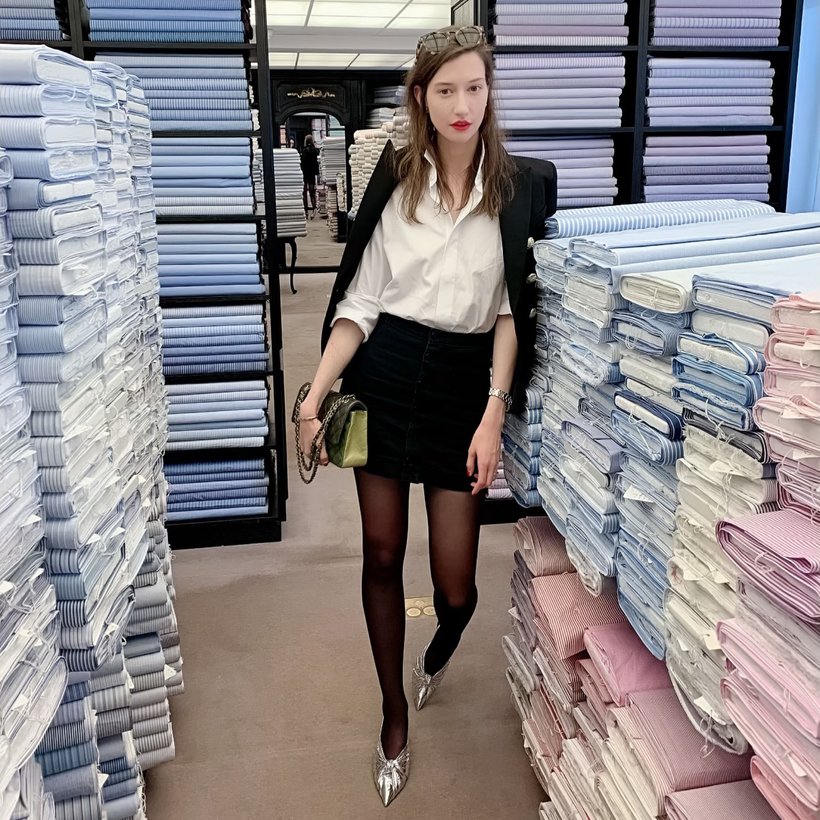When Hannah lived as a man, she worked on Wall Street with a woman who would sometimes wear a black Hervé Léger bandage dress. The image of the littlest of L.B.D.’s—an indelible relic from the bygone Linda-Cindy-Christy era—is stored deep in the G-Drive of her hippocampus. “It was like armor,” Hannah remembers as we shop for a new look in San Francisco. “And at the same time, the opposite of armor. It revealed and accentuated exactly who she was.”
I meet up with Hannah and Maya Deschamps-Braly near Union Square. With her dark hair parted by bobby pins, Hannah (who asked to be identified only by her first name) resembles Neve Campbell in The Craft. She is in head-to-toe black; her cropped T-shirt has a pentagram circled by the words Today’s the day, Satan!, and it screeches to a halt at her final rib. Deschamps-Braly has fashioned a voluminous camel coat into a dress that is held together by a quilted Chanel bag. Hannah is from where they filmed Jersey Shore; Deschamps-Braly is from Paris, by way of Bulgaria. Hannah is a trans woman returning to tech after a sabbatical; Deschamps-Braly is a cis woman, former model, and altruist whose primary tool is her considerable superpowers of stylishness. “It’s feels good to use clothing in a purposeful way,” she says.
The pair is in their 30s. Each stands north of six feet and have the pale skin and matte-red lips favored by Bond villainesses and editors for French Vogue. I follow them down Maiden Lane’s cobblestones, past Martin Margiela and a Wolford window declaring, HUNT OR BE HUNTED. They are shopping for outfits to wear to Hannah’s upcoming interviews. “I want to be more visible,” she says. And so we enter a boutique.
Shopping Strategically
The Re:store space was once occupied by Theory, but it now sells those very-2019 brands you see when you’re swiping through Instagram, such as Kotl, BLDWN, and h h e r. The three-story shop has been washed lavender, and the walls offer positive, handwritten affirmations cribbed from memes and Brené Brown, such as all that you need is no further than within.
Deschamps-Braly began styling transwomen in 2015. Many were friends and patients of her husband, Dr. Jordan Deschamps-Braly. He runs a renowned plastic and craniofacial surgery office in San Francisco specializing in, as it’s known in the trans community, facial feminization.
Many of her clients work in tech and are about to “go full-time”—which is to say to fully present as women; they have turned to Deschamps-Braly to help them craft a new look. “It takes years for women to learn what looks good on them,” says Deschamps-Braly, who credits her robust business to many word-of-mouth referrals. “I guess I help them cut the line.”
Hannah, who was a patient of Deschamps-Braly’s husband, stalks through narrow aisles. She appraises purses with hidden backpack straps (“so San Francisco,” she says); a white, ruffled, crop-top bra thing last seen on Elly May Clampett; and a slip dress the color of turmeric that Deschamps-Braly said could work under a blazer. As they walk into a fitting room, Hannah whispers, “But I don’t have a blazer.”
“We’ll find you one,” Deschamps-Braly says reassuringly.
“It takes years for women to learn what looks good on them. I guess I help them cut the line.”
Shopping is a strategic move for the software engineer. “Tech companies now aren’t only looking for the most qualified,” she insists. “They are also looking for people they want to work with every day.” For now, Hannah says, she wants to work at a medium-sized company. “I’m not sure I’m ready to be a fang.”
Fang?
“F-A-A-N-G,” she explains while contemplating a pair of white, high-waisted jeans. “Facebook, Amazon, Netflix, Google … What’s the other A? Oh, Apple.” Deschamps-Braly hands her a bright calico dress. Hannah purses her lips into a maybe, which is met with a Gallic shrug.
Best Feet Forward
Hannah started transitioning when she was 34. She had spent her career on the tech side of a Wall Street hedge fund. “High-frequency trading,” she says with a grimace. “I was part of the problem. Not anymore. I do no harm.” She left New York, went to Burning Man, and drove an R.V. around the country before ending up in San Francisco, leaving everything behind but her talent for programming. (She says there are so many trans women working in software engineering that it’s nearly a bad cliché. Along the lines of, say, gay male hairdressers.)
Despite the rising number of violent deaths of transwomen around the United States—18 so far this year—San Francisco is a safe harbor. And despite the current state of things in the city (a growing number of homeless, a growing number of billionaires), Hannah still finds the spirituality and connectedness she was seeking here. What she can’t find is a good pair of shoes.
She says there are so many trans women working in software engineering that it’s nearly a bad cliché. Along the lines of, say, gay male hairdressers.
“I don’t have a problem finding clothes, I have a longer torso and naturally wide hips,” she tells me later over coffee. “And estrogen is a wonderful, magical thing.” But in women’s shoes, she wears a size 12 or 13, and those are rarely, if ever, seen on a sales floor. “Can’t even, like, Jessica Simpson make them in my size?” she wonders.
”Non, non, non,” Deschamps-Braly interjects with a giggle. “Not Jessica Simpson! Trust me. I am working on this.”
Hannah looks down at Deschamps-Braly’s leopard-print Givenchy boots. “Sometimes,” she says, “shoes are more than just shoes.”
Jason Sheeler is a writer based in San Francisco

